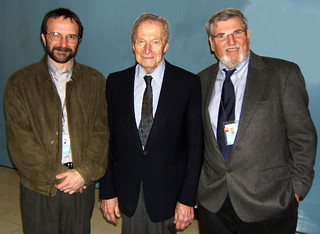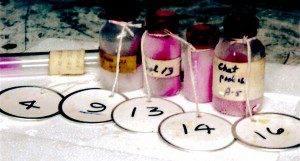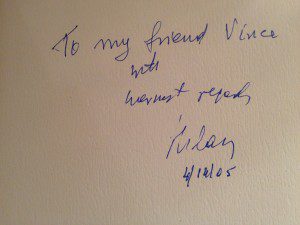

In the 1930s Max Theiler had found that propagating yellow fever virus in an unnatural host – the chick embryo – dramatically reduced its capacity to cause disease in humans. Theiler’s work (which garnered him a Nobel Prize) lead to the production of the infectious, attenuated yellow fever vaccine which helped to vastly reduce the global incidence of yellow fever. Koprowski was inspired by Theiler’s work and decided to take a similar approach to developing a poliovirus vaccine – his first efforts involved passage of a type 2 strain of poliovirus in mice and then in cotton rats. After passage in rodents, the virus did not cause paralysis in monkeys. Koprowski tested the candidate vaccine strain in humans, and ultimately produced two other attenuated poliovirus strains. By the 1960s these attenuated poliovirus vaccine candidates had been tested in millions of humans. However, they were never licensed for use in the US. While Koprowski was carrying out his work, Albert Sabin was also developed attenuated vaccine strains of poliovirus. Both Sabin’s and Koprowski’s strains were tested side by side in a monkey neurovirulence test carried out by Joseph Melnick at Baylor University. Sabin’s virus strains were slightly more attenuated, and in 1961-62 those were selected for licensing in the US. Sabin’s oral poliovirus vaccines (OPV) have been the mainstay of the World Health Organization in its polio eradication campaign.
Koprowski’s polio vaccines were tested by human clinical trials, notably in the former Belgian Congo in 1957-58. It was subsequently suggested that this clinical trial initiated the AIDS pandemic. The idea, first proposed by Tom Curtis (19 March 1992 “The Origin of AIDS: A startling new theory attempts to answer the question, ‘Was it an act of God or an act of man?” Rolling Stone pp. 54€“9, 61, 106, 108) and subsequently by Edward Hooper in ‘The River‘, was that Koprowski had propagated the vaccine strains in kidney cell cultures produced from locally captured chimpanzees. If these animals were infected with the precursor of HIV-1, simian immunodeficiency virus (SIV), then the virus might have entered the human population during the polio vaccine trials. This hypothesis was subsequently shown to be incorrect as phylogenetic analysis showed that the main group of HIV-1 viruses, the M group, clearly crossed from chimpanzees to humans in the early 1900s.
A committee was established to investigate the virological aspects of the HIV-polio vaccine controversy, and towards the end of its work I was asked to join. When it was discovered that samples of Koprowski’s polio vaccines were frozen at the Wistar Institute in Philadelphia, it was decided to determine whether these vaccines had been propagated in rhesus monkey or chimpanzee cells.
I was given the job of dividing and coding the samples. I met a representative of the Wistar Institute in the parking lot of a restaurant just off the New Jersey Turnpike, halfway between New York and Philadelphia. He handed me a white styrofoam box, packed with ice, that contained vials of the Koprowski vaccine. To the uninformed observer, it might have looked like a drug exchange.




Although I had spoken with Dr. Koprowski several times on the telephone, I did not meet him until 2005 when he presented a talk on the history of rabies in the History of Science series at Columbia University Medical Center. I was his host for that visit, during which I was photographed with Dr. Koprowski and Dr. Rich Kessin, another Columbia professor. We invited Dr. Koprowski to dinner after the seminar but he declined, but he did want to have a drink together. After being warned by his driver not to keep him too late, we walked to a local bar and Dr. Koprowski ordered a Boodles gin martini. The bartender noted that he didn’t receive many calls for that brand. Dr. Koprowski said it was his favorite gin. We talked for a while and then returned Dr. Koprowski to his car for the trip back to Philadelphia. During his visit I had Dr. Koprowski autograph my copy of Listen to the Music (photo). He wrote: “To my friend Vince, with warmest regards, Hilary, 4/14/05.” It was the first and last time I saw him.
I would like to relate one last story which has nothing to do with me, but is irresistible. It takes place in the opening pages of Listen to the Music. Koprowski and his technician Thomas Norton are about to drink an early version of his attenuated polio vaccine. The virus has been passaged in rats and appears to be attenuated in monkeys. On a January day in 1948 Koprowski and Norton are in a laboratory at Lederle Laboratories in Pearl River, NY., where they are blending the brains and spinal cords of rats that had been infected with the vaccine strain virus. They both drink a milliliter of the cold, greasy, mix which flows thickly over their tongues and is difficult to swallow.
Here is the best part:
When he can speak, Norton asks, “Have another?”
“Better not,” Koprowski says. “I’m driving.”

I wrote a book about the history of Lederle Laboratories that was printed in 2012 for Pfizer employees in Pearl River. It inciudes mention of the early work of Hilary Koprowski and that his first testing of the oral polio vaccine on human was done with 20 children from Letchworh Developmental Center in Stony Point. NY (Rockland County). I used the book “Listen to the Music” in my research. I had also interviewed the son of Dr. Herald Cox, who as the director of research at Lederle at that time and had hired Koprowski. The story of how the first oral polio vaccine certainly is facinating. As your article mentions, Koprowski was never given the recognition he has so rightly deserved.
I am giving a talk about the book and what i learned at the Tappan Library on Saturday, May 18 at 2pm.
Tappan Library book talk on May 18:
http://www.rocklandtimes.com/2013/05/09/potanovic-talks-lederle/
Fore more information: georgep123@optonline.net